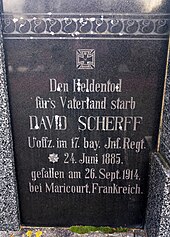Royal Bavarian 17th Infantry Regiment "Orff"

The 17th Infantry Regiment "Orff" was a regiment of the Bavarian Army stationed in the Germersheim Fortress . In 1914 it was under the control of the 6th Infantry Brigade .
history
founding
On July 24, 1878, the 6th Jäger Battalion , 8th Jäger Battalion and 10th Jäger Battalion had to meet in Germersheim, they were united to the 17th Infantry Regiment on October 1 of the same year. Two days later, Lieutenant General Karl von Orff (1817–1895) was appointed head of the regiment. Its founding battalions had already been deployed in the Franco-German War , including the battles near Weißenburg , Wörth and Sedan and the siege of Paris .
In 1881 the 11th company had to give it up to found the new 18th regiment . On April 18, 1891, when the new Zweibrücken garrison was founded, it also lost the entire 1st Battalion, which, however, returned six years later. In the meantime, an IV Battalion was formed in 1893 , to be combined with the IV Battalion of the 18th Regiment on April 1, 1897 to form the 23rd Infantry Regiment . After Orff's death in 1895, it took over his name.
In October 1900 the 2nd Battalion was hit by a typhus epidemic , of which it is not known how many people died. In 1904, some of the soldiers were sent to German South West Africa to suppress the Herero uprising .
First World War
The First World War began for the regiment with the announcement of mobilization on the evening of August 1st, after a state of war had been declared on Bavaria the day before . There was enthusiasm for the war in Germersheim . The regiment left the city between August 4th and 7th. For the next four years it was used exclusively on the Western Front as part of the 3rd Division .
It was initially used as part of the 6th Army in Lorraine , and in pursuit of the retreating enemy it crossed the French border on August 22, 1914. After the heavy fighting between Nancy and Épinal from August 23 to September 14, it fought in late September / early October 1914 on the Somme and from October 30 to November 15 in the Battle of Flanders . This was followed by trench warfare in Flanders until August 22, 1916 , and then from August 24 to September 19, participation in the Battle of the Somme . After trench warfare at Armentières , it was almost completely destroyed in the Battle of Messines in 1917, with only three companies remaining. On the position battles in Lorraine (16 July to 9 October 1917), Champagne (10 October 1917-2. January 1918) and north of the Aillette (4 February to 20 March 1918) was followed by a use in the German spring offensive between March 21st and April 1st. The rest of the war was spent in various trench warfare.
3,426 men fell, died in accidents or in captivity during the war. 73 men died of illnesses and 473 went missing, so that the regiment suffered a total of 3,974 deaths. A further 8,242 men were wounded and 1,785 were taken prisoner.
Whereabouts
After the armistice of Compiègne , the remnants of the regiment reached Gerolzhofen , where demobilization and eventual dissolution took place on December 14, 1918 . The Becker volunteer company was formed from parts of the regiment on February 20, 1919 and transferred to the Götz volunteer detachment. After its dissolution on May 30, 1919, the relatives were integrated into the 2nd Battalion of Reichswehr Infantry Regiment 46 at the beginning of June 1919.
The 7th Company of the 21st (Bavarian) Infantry Regiment took over the tradition in the Reichswehr .
Worth mentioning
In Germersheim, the regiment's garrison town, both “Orffstrasse” and “17 er Strasse” , which joins Orffstrasse, were named after the regiment. Furthermore, there is a traditional association in Germersheim, which has set itself the goal of reviving the 17th Royal Bavarian Infantry Regiment in correct uniforms.
literature
- Joseph Probst: History of the city and fortress Germersheim. 2nd Edition. Verlag der Buchhandlung Johann Richter. Pirmasens 1974, ISBN 3-920784-16-2 . Pp. 136-148. Note: There is also a newer edition of this book, but the page numbers may not match correctly.
- Eugen Polap: Military history of the city and fortress Germersheim 1900–1975. In: City of Germersheim (ed.): Germersheim. Contributions to the city's history 1900–1975. City administration. Germersheim 1976. pp. 112-115, 120-123.
- Johann Riegel: The KB 17th Infantry Regiment Orff (= memorial sheets of German regiments. Bavarian Army . Volume 52 ). Schick, Munich 1927. Available online: digitized version of the Württemberg State Library .
Web links
Individual evidence
- ↑ Website on the 17 memorial in Germersheim
- ^ Jürgen Kraus: Handbook of the units and troops of the German army 1914-1918. Part 6: Infantry. Volume 1: Infantry Regiments. Publishing house Militaria. Vienna 2007, ISBN 978-3-902526-14-4 . P. 454.
- ↑ Reinhold Klotz: Germersheim - my hometown . Germersheim, 1994. p. 384. According to the information given there, the name of the regiment was named, according to an information board attached to the street sign (there without further source information) directly after the former owner of the regiment, Karl von Orff.


